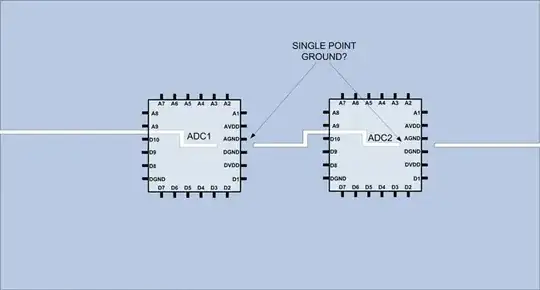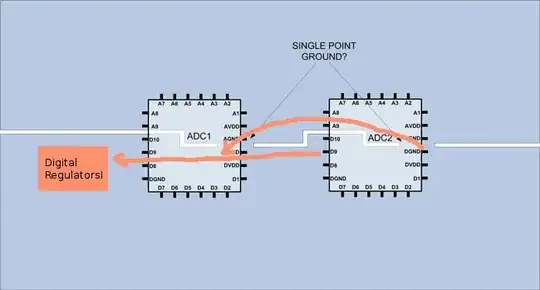The reason is quite simply that we are trying to make a 'moat' with a single bridge across it. With two cuts in the plane, the analogue returns currents from each device can get mixed together, introducing noise from one set of ADC inputs to the other. In addition, we have provided a circular route for the digital returns to go around the analogue side of the ADCs.
Digital noise from ADC2 could take a path behind it, as could digital noise from ADC1. Put a little curved trace around the analogue side of ADC2 from the two cuts; this is where some digital noise could flow.
I have actually had to fix a board that did precisely this, and the faults were subtle and induced a great deal of hair pulling.
To avoid the issue, do the following (works for relatively slow analogue, fast analogue have different segregation requirements - Note 2):
Do not route digital power in the same area (on any layer) in the same area as the sensitive analogue signals. I have found that such power tends to re-radiate from other planes. Note 1.
Ensure the primary power source is on the digital side of the board. This ensures that all returns paths move away from the analogue side.
Do not take high speed tracks in the same area as the analogue circuitry (on any layer)
Arrange the ADCs / DACs or whatever such that there is a single gap in the return planes. If you have differing speed analogue signals, put the fastest ones closest to the gap.
If you are driving the analogue circuitry with a separate regulator, put the regulator such that is spans the split in the plane with the output and feedback (if used) on the analogue side. If using a ferrite (a very common practice), then the same placement rule applies.
Do separate the power either through a ferrite or regulator.
Note 1. This is primarily due to the limitations of layout tools. If I could make the tool attach a via to only specific layers, I would, but this is very difficult with most existing toolsets.
Note 2. Use a separate moated area (each with its own local ground and ferrite / regulator) for each section with high speed analogue signals.
See this excellent guide for some more details.
[Update] Added note on slot antenna
The two cuts in the plane can produce a slot antenna, where a great deal of the digital noise can accumulate, depending on the frequency content and the aperture sizes and distances.
HTH

